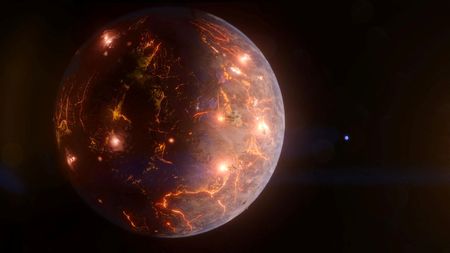By Will Dunham
WASHINGTON (Reuters) – An Earth-sized planet orbiting a dim star in our galactic neighborhood is offering some of the best evidence to date of volcanism beyond our solar system, with observations suggesting a rugged and rocky world tormented by constant eruptions.
Scientists said on Wednesday the planet, the third detected orbiting this particular star, is likely covered with volcanoes – similar to Jupiter’s moon Io, the most volcanically active body in our solar system. In our solar system, Earth and Venus are volcanically active, as are some of Jupiter’s moons.
The planet’s volcanism was not directly observed but rather inferred due to its significant gravitational interaction with the larger of the two other planets orbiting the dim star. The gravitational tug from the larger planet may squeeze and flex the newly identified one, heating up its interior and causing surface volcanic activity, similar to Io, the researchers said.
Planets beyond our solar system are called exoplanets.
“There is not yet any direct observational evidence of exoplanet volcanism, but this planet is a particularly likely candidate,” said University of Kansas astronomy professor Ian Crossfield, one of the authors of the research published in the journal Nature.
It is a planet that does not rotate – with one side perpetually in daylight and the other in darkness.
“On the dayside, it is too hot for liquid water, so it is likely very dry and hot – likely a desert. On the night side, there is possibly a large icy glacier,” said study co-author Björn Benneke, head of the astronomy group at the University of Montreal.
“The most interesting region is near the terminator region where the day and nightside meet. Here, water from the nightside glacier can melt and possibly form liquid surface water. In addition, there is likely volcanism all around the planet, even under the ice on the nightside and possibly under the water near the terminator,” Benneke said.
The planet is located in the Milky Way about 86 light-years away from our solar system in the direction of the constellation Crater. A light year is the distance light travels in a year, 5.9 trillion miles (9.5 trillion km).
It is slightly larger than Earth and orbits very close to a red dwarf star – a type much smaller than our sun, with relatively low mass and temperature – completing its elliptical journey around it in only 2.8 days.
Its surface temperature appears to be slightly warmer than Earth. It is situated on the inner edge of what is called the habitable zone, or Goldilocks zone, around the star – not too hot and not too cold, perhaps able to maintain liquid water on the surface and harbor life.
“I imagine a rugged, young surface for the planet after many millions of years of constant volcanic activity. Since the gravitational effects don’t care about day and night side, I also suspect the volcanic activity to be evenly spread over the planetary surface,” said University of California, Riverside planetary astrophysicist and study co-author Stephen Kane.
“Since the planet is so volcanically active, it is still contributing gases to the atmosphere from the interior. As such, the planet probably still has an atmosphere. The planet is unlikely to be habitable, however, since the total amount of energy makes for a quite hostile environment. Who knows? Life may find a way,” Kane added.
Its orbit is sandwiched between the two other planets – the innermost one about 20% bigger than Earth and the outermost one about 250% the size of our planet.
The researchers spotted the planet using NASA’s Transiting Exoplanet Survey Satellite (TESS) and the now-retired Spitzer Space Telescope, as well as some ground-based observatories.
“There are still many unknowns regarding volcanism and how long a planet can maintain outgassing processes,” Kane said, referring to the release of trapped gas that occurs with eruptions. “We only recently confirmed that Venus, Earth’s twin planet, is volcanically active.”
(Reporting by Will Dunham, Editing by Rosalba O’Brien)





